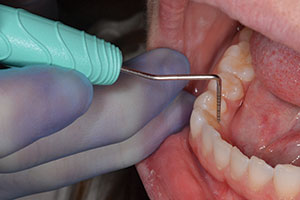t is important for the orthodontic practice to promote good oral home care by its patients. Patients often determine the long-term outcome of their treatment based on how well they take care of their oral health between appointments and post-treatment. Achieving excellent patient home care and oral health improves clinical results while enhancing patient flow and practice growth. Your practice is a business, and satisfied customers are the best way to grow that business.
THE VALUE OF EFFECTIVE HOME CARE
It is the role of the orthodontic team to motivate patients to take command of their oral hygiene during orthodontic treatment. Traditionally, patient and parent education and motivation were the only available tools to achieve compliance and improve home care. Technology has made the use of power toothbrushes possible in securing optimal oral hygiene, but the challenge is to motivate orthodontic patients to use them consistently to gain the best possible result from their treatment plan.
THREE SYSTEMS TO ACHIEVE EXCELLENT ORTHODONTIC CARE
(1) Patient Education and Motivation
Guiding a patient toward good home care requires proper education and motivation. This can be achieved by implementing effective systems for repeatedly communicating the value of home care to patients. Consistent implementation by the entire dental team is critical in promoting treatment effectiveness. Supportive scripting along with age-appropriate educational models, brochures, and handouts make the process more effective.
(2) Regular Patient Visits
It is important that patients keep their on-going appointments with the orthodontic practice. This is critical in order to supervise their progress and make all necessary adjustments in a timely manner. A comprehensive system for patient scheduling is important. This needs to be supported by effective scripts to build value for each appointment, resulting in lower no-show and cancellation rates.
(3) Optimal Oral Health
Proper daily brushing is essential to maintain tooth and gum health throughout the orthodontic treatment process. A study done by the Harvard School of Dental Medicine demonstrated that power toothbrushes generally are more effective than manual brushes in home care, achieving better levels of plaque control and gingival health—including superior plaque and gingival index scores compared to manual brushes as well as less bleeding on probing. Brushing with a power toothbrush can encourage and motivate patients toward better oral health because they are able to see the results of brighter teeth and healthier gums almost immediately. Many power toothbrushes are available, but my preference is the Philips Sonicare Elite. A study conducted by Morley Research of more than 900 registered dental hygienists (RDHs) and more than 1,700 patients using the Sonicare Elite toothbrush found the following:
•RDHs indicated that 95% of patients showed improved overall oral hygiene.
•RDHs noted a significant improvement in patient compliance with recommended oral hygiene.
•RDHs indicated that 92% of patients’ periodontal status improved.
•Two out of 3 RDHs noted an improvement in their own overall oral health.
•RDHs observed a reduction in extrinsic stains in more than one out of 3 patients.
•RDHs observed a reduction in bleeding in nearly half of their patients.
•RDHs observed a reduction in visible plaque accumulation in more than half of their patients.
•One in 3 RDHs considered their gums to be healthier after using the Sonicare Elite.
Healthy brushing begins a cycle of compliance that benefits the patient and the practice alike. Timing mechanisms encourage patients to brush for the 2-minute period dentists recommend. This continues the cycle of compliance because motivated patients see pronounced clinical results and realize better check-ups. In order to capitalize on this benefit, it is important that the orthodontic practice systematically incorporate a power toothbrush into patient education and consistently recommend or dispense it to all patients who may benefit from this technological tool.
OPTIMAL ORTHODONTIC CARE AND PRACTICE PROFITABILITY
Good oral care compliance, effective systems for patient education, and efficient care coordination between the orthodontic and general practice all translate into significant benefits in terms of practice efficiency, productivity, and profitability. These systems allow the doctor and team to make better use of their time as treatment progresses according to the scheduled plan. The result is a schedule that is significantly more efficient, with less unexpected changes. In most cases, this enables the practice to add 3 to 4 patients a day to the schedule without compromising quality of care. This increased production will mean greater profitability for your practice.
SUMMARY
Patients can significantly affect the outcome of their orthodontic treatment. A practice committed to developing the right systems, scripts, and educational materials will experience a more satisfied patient, increased efficiencies, and higher profits. Educating and motivating patients to maintain their oral health and providing recommendations or dispensing of home care tools such as a power toothbrush increases patient compliance, positively impacts treatment outcomes, enhances customer service, and generates a new revenue stream for the practice.
Roger P. Levin, DDS, MBA, is founder and chief executive officer of Levin Group. A consultant for more than 19 years, Dr. Levin has published more than 2,700 articles and 49 books. He currently serves as the practice management editor of 6 leading dental journals as well as a columnist for the Journal of the American Dental Association. He is a regional recipient of the 2004 Ernst & Young Entrepreneur of the Year Award and is scheduled to be inducted into the Entrepreneur of the Year Hall of Fame later this year in Palm Springs, Calif. As a lecturer for the past 19 years, Dr. Levin addresses more than 22,000 dentists annually in more than 100 seminars. He can be reached at (888) 973-0000 or consulting@levingroup.com.











